Laptop chargers face a hard life. They’re repeatedly plugged and unplugged, coiled up, stuffed into bags, thrown around, and just generally treated fairly poorly. Combine this with fairly lightweight design and it’s not uncommon for a laptop charger to fail after a few years. It’s usually the connector that goes first. Such was the case when I found myself face to face with a failed Macbook charger, and figured it’d be a simple fix. Alas, I was wrong.
Unlike most PC manufacturers, who rely on the humble barrel jack and its readily available variants, Apple liked to use the Magsafe connector on its Macbook line. This connector has many benefits, such as quick release in the event someone trips over the cable, and the fact that it can be plugged in without regard to orientation. However, it’s not the easiest to fix. When the charger began failing, I noticed two symptoms. The first was that the charger would only function if the cable was held just so, in exactly the right orientation. The other, was that even when it would charge, the connector would become very hot. This led me to suspect an intermittent connection was the culprit, and it was quite a poor one at that; the high resistance leading to the heat issue.
It’s at this point with any other charger that you get out your trusty sidecutters, lop the end off, and tap away at Digikey to get a replacement part on the way. With Magsafe? No dice. Replacement parts simply aren’t available — a common problem with proprietary connectors. I endeavoured to fix the problem anyway. I began to strip away the metal shell around the back of the connector with my sidecutters, and eventually an angle grinder. A Dremel would have been the perfect tool for the job, actually, but I persevered regardless. After much consternation, I had the connector peeled back and was able to identify the problem.
The cable of the Macbook charger consisted of a centre conductor sheathed in Teflon, which was then surrounded by two layers of shield wound in opposite directions. The center conductor is soldered to one tab which connects to the V+ pins of the Magsafe connector, and the shield connected to the other tab, leading to GND. The issue was that after many years of use, the continual flexing of the cable had caused the shielding strands to break over time, eventually making poor or no contact. This explained the symptoms we were seeing, so I was confident that I’d found the root cause. After cleaning up the solder tabs of the connector, I freshly stripped the charger wiring and soldered everything back into place. A few checks with the multimeter against the pinout indicated everything was connected correctly, and plugging the charger back into the Macbook indicated the repair was successful.
Aw, Nuts!
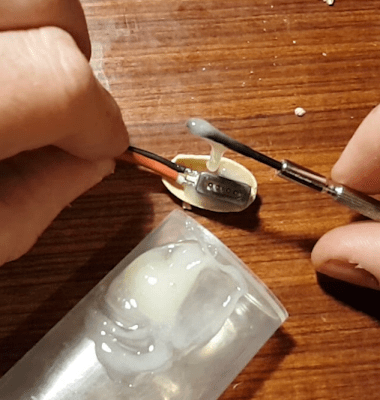
There was now just one small problem to fix. While the charger was functional, it was difficult to insert and remove since the aluminium casing had been removed. This, combined with the now-exposed wires, meant something had to be done. I decided to fashion a new protective cover for the connector, and as luck would have it, I had the perfect parts to hand.
Have you ever tried to open a pistachio nut that isn’t yawning open along the seams? It impossible for mere mortals to do without tools. A pistachio shell would serve quite well as the protective outer case for the connector. The Magsafe was placed inside and the shell was filled with epoxy to hold everything together and insulate the wires.
It was difficult to hold the connector in position within the shell; if I were to attack this problem again, I’d have tacked the connector in place with superglue before filling the shell with epoxy. Regardless, I persisted. After a longer wait then expected due to the fact I’d accidentally purchased the 24-hour, not 5 minute, epoxy, it was cured. A quick tidy up with a file and all was good to go.
I was glad to have the charger repaired. The pistachio nut encasement proved to be a worthwhile solution, giving the connector much needed robustness after being stripped down and rebuilt. It gets the odd stare here and there, because at the end of the day, there’s a pistachio sticking out of the charge port.
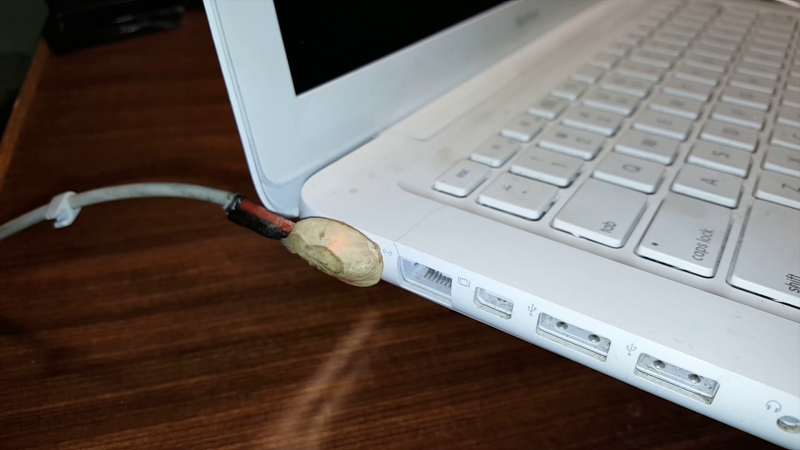
But hey, sometimes that’s the price you pay for progress.
Fundamentally, working with proprietary connectors can be a real pain. They’re hard to source, and can completely disable a piece of equipment if they can’t be repaired. However, with a little perseverance and creativity, it is sometimes possible to save the day, if you’ve got the nuts to try.

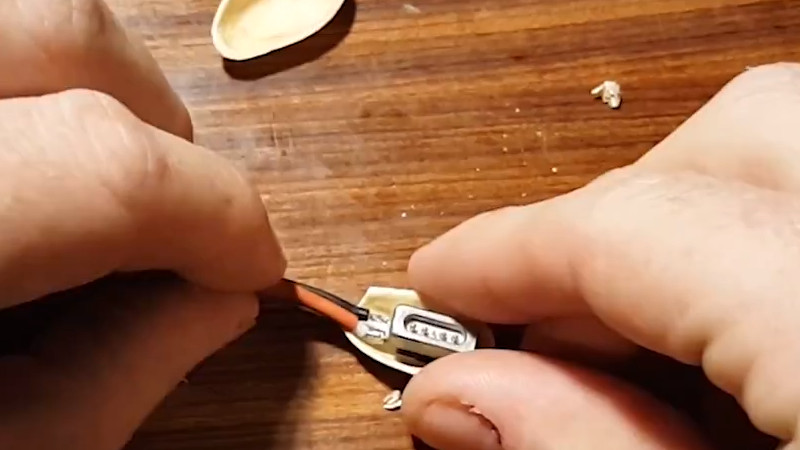
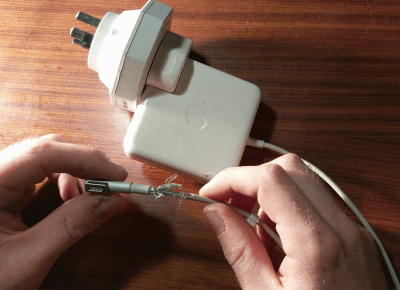
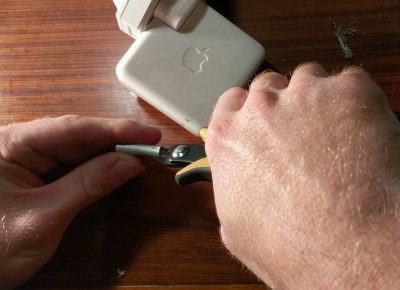














“…tap away at Digikey to get a replacement part on the way. With Magsafe? No dice. Replacement parts simply aren’t available — a common problem with proprietary connectors.”
Well, actually, they are available…
2.1mm to Magsafe 1:
https://www.adafruit.com/product/3546
2.1mm to Magsafe 2:
https://www.adafruit.com/product/3547
Those aren’t replacement parts.
Maybe not, but they’re probably better than half a pistachio shell filled with hot glue :)
But I want a pistachio nutshell filled with hot glue!
……….and a pony.
It’s a hack!
epoxy is several times better than hot glue.
Not when you need to glue something that contacts with moisture. Epoxy swells and turns to goop after a while.
There’s a fine line between being a genius and being aa nut. Only dictated by success. Or in this case, the line was drawn with hot glue.
Hey if it’s stupid and it works… ok, it’s still stupid but it does work and that’s the point.
He used epoxy, he even mentions he accidentally purchased 24h curing epoxy by accident and had to keep it in place for that time.
But I guess you were just jesting and details like that matter not.
Replacement magsafe cables with ‘tails’ are readily available on ebay, but require the charger itself to be cracked open (or an unseemly cable join).
What do you do with the other half?
Wait for the follow up article on the Earphone fix.
Nice.
Directions unclear. Nuts stuck in ear holes.
Which nuts?
That’s just nuts!
It looks very,
(Googles poistachio)
Seedy.
I’m “pissed at you” for that remark!
B^)
You could’ve 3D printed a connector instead of this ugly bodge.
Actually, I applaud him for not being one of those, “..so, I just 3D printed a replacement…” guys. Not everyone has, nor wants a 3D printer and his much-quicker solution works quite well.
Yeah, only on a slow news day would HaD post an article about 3D printering a replacement connector.
No, you could have 3D printed a connector. I couldn’t. I don’t have a 3D printer.
You’re more than welcome to send me one though :D
I always knew that people who chose Mac are a little nutty. Especially ones who like to make things and yet chose that most closed platform!
He’s not necessarily nutty, could just be a little reluctant to shell out for something more expensive.
It’s okay, I’ll see myself out.
Comments like these make it all worthwhile!
Next step: Taking good photos with a potato.
Next next step: Making good PCBs with tortilla.
http://www.seattlerobotics.org/encoder/apr98/breadbrd.html
:o)
https://www.youtube.com/watch?v=rdzCv_9eaoM
Hmm… Instead of lasers, I wonder if a record made of hot glue would sound okay. Perhaps warmed, pressed and frozen before playing. Maybe frozen then etched.
Etched, interesting. Maybe I could use plasma or electrolysis to etch a record into a disk of metal. Electromagnets or piezo elements to do fine adjustments.
Did anybody tried LASER cooking, yet?
:o)
At my hackerspace when we first got our lasercutter laser, we tried lighting a birthday candle with it. It burnt a hole straight through the cupcake it was embedded in.
FYI: many photographers refer their camera (if they feel it is not worth bragging about) as a potato.
B^)
This fix is so the after market battery will explode quicker?
What aftermarket battery?
“This connector has many benefits, such as quick release in the event someone trips over the cable, and the fact that it can be plugged in without regard to orientation.”
Surely both of these “advantages” apply to the standard barrel connector, as well?
In the case of the barrel connector, only the part about the orientation.
Tripping in a cord that uses the barrel connection will bring the notebook down in more cases than those where a magsafe is used.
I suppose if you had an inline barrel with a 6in/15cm pigtail, which had some other laptop connector, it could serve as a form of quick release from any orientation if the cord is pulled. Another benefit being that as the pigtail w/ the laptop connector wears out it can be replaced without junking the entire charger.
Though 99% of the benefit I see with Magsafe is when I tilt the laptop down into something by accident it releases rather levering the weight of the laptop.
I had a toshiba laptop with sort of a stunted barrel connector that would come out every time, unless you yanked it at a 90 degree angle.
Is that barrel connection center-positive, or center-negative?
Things like this are another use for those much maligned “helping hands” that Radioshack sold.
https://www.radioshack.com/products/radioshack-helping-hands-with-magnifier
Umm… MAGsafe connector waving about MIGHT be looking for big chunk of iron to cling to? Just a thought, never touched the actual connector. ALSO, + for hack – I hate cable failures, and +++ for ‘stashio shell! Gonna start saving a few – I’m looking at YOU, micro-USB short-lived expensive pre-junk!
Were there no MACadamia shells available?
B^)
You mean the Queensland nut? I think Lewin’s in Victoria… enough said!
Now there is a pun in “MAC” and “academia” in that, but I’ll leave it to someone else…
Needed same thing with my automotive GPS unit so I could put it in my shirt pocket and just listen to it for turn by turn instructions. Just cover the GPS unit with saran wrap and insert the connector through the saran wrap, then cover the connector with epoxy putty.
I get that it’s not an issue for most people, but unshielded magnets absolutely suck around metalshops.
I repair phones and computers as a side job. If you pull off the metal shell around the actual contacts, you can pull the connector itself out of the metal shell and then repair the connection and put everything back. The connector is definitely not a “molded in” thing where they are pouring molten aluminum around a plastic connector.
Hmmm… molten aluminum is about 660 degrees Celsius.
What about the opposite?
Very entertaining, and usable for when you need a quick fix. My magsafe connector went out and I followed iFixit tutorial with a replacement cable like this one. https://www.google.com/search?q=replacement+magsafe+1+cord&safe=active&client=ms-android-sprint-us&sa=X&biw=360&bih=560&tbs=vw:l,ss:44&tbm=shop&prmd=sivn&srpd=18232819997153332969&prds=num:1,of:1,epd:18232819997153332969,paur:ClkAsKraXz58hpmgjeJUY7BSMwoDXEGLzTvLiE4xJ-TW-FjRyJpgOTR7OExTeJkuTMPiwCbqpqDes9wktzuG6HAWJeNTPfFCx7ZCi4hM4fTGmDfEqYZvaAY4KBIZAFPVH70fUDEDDR4k_1bdnOUNWE7hvhe59g&ved=0ahUKEwjjmJTw_77YAhWI5IMKHfC1DxMQgjYIqgQ
Not nearly as customized but has been working great for 8+ months.
“I’d accidentally purchased the 24-hour, not 5 minute, epoxy”
That’s good, because “5 minute epoxy” is rubbish and never really sets hard.
If there are multiple breaks, you could put “5 minute epoxy” in a couple of places, and use long curing epoxy in others, so the “5 minute” stuff will hold the parts together long enough for the other stuff to cure.
My favourite is tack-gluing with superglue, then going for epoxy. I patented this term in a Youtube video sometime last year. ;)
As shown the cable will fail where it terminates. Always look for fail points. The second or more often fail point is when one wraps the cable around anything. Don’t wrap! The cable should fail anywhere not at both stressed ends.
Apple’s design has the cable flexing at a hard end of the connector AND at the corner of the protective bulk of the case. Two poor designs in one. But this really comes down to sexy looks vs. simple robust standard cord. A respectable sound engineer knows not to wrap microphone cables. The is because of coax construction. The braid breaks easily when twisted or bent sharply. If we could only do without coax, but mics need it. But because coax is round and two conductors are standard zip type cable, desighners and fashonists determine which is right for us(them).
I routinely cut headphone cords and solder to the stub of the plug and cover with either fast epoxy or silicone and just free form the latter from the tube. A wet finger can touch and flatten once each touch to form. It’s close to a right angle type but the cord is tied in a knot around the stub so it’s robust and essentially pulls straight out without harm.
“Nutjob,” comes to mind. 1 min epoxy also exists. But where do you find 1 pistachhio?!? Buy a whole bag and save the others for eternity? Sell them singley on eBay? Oh – ok. Some nutjob will buy them. Lessen here…! You apple laptop people out there… build this up w a flex-mover / reduce right from the POS. Known weak spot? PreFix it. And a nice warning to others. Do not buy.
The cartoon series “Milo Murphy’s Law” has a continuing sub-plot about time travelers returning to the present to find pistachios to restore them in the future.
http://disneyxd.disney.com/milo-murphy-s-law
Imagine FM bug in Wallnut shell. True spy technology.
There are tons of things on Thingiverse for magsafe 1 and 2 for providing strain relief to prevent cord failure.
… We started using left over grenade pins as a quick fix to secure some “items” … When we started running out of pins someone had the bright idea to just grab a couple of the pins out of the “box”…
That quick fix didn’t end nearly as nice as this nutty solution, tho evryone was shell shocked!
:)